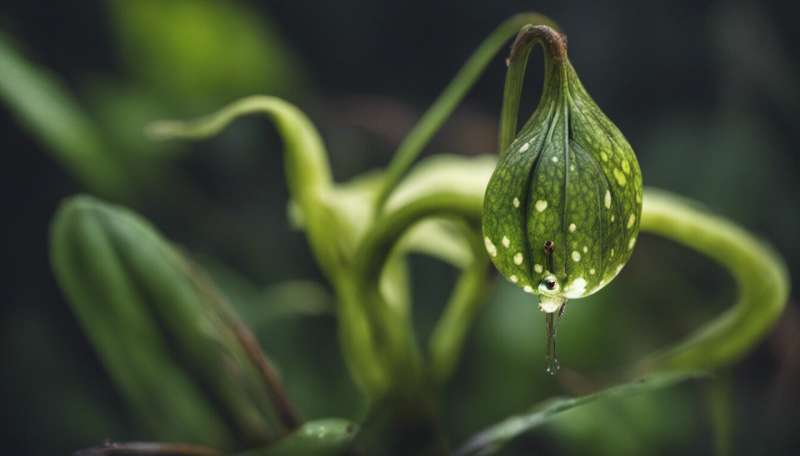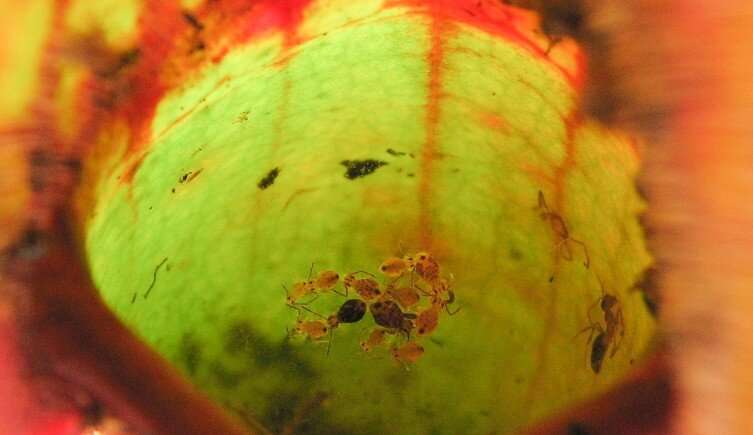This article has been reviewed according to Science X's editorial process and policies. Editors have highlighted the following attributes while ensuring the content's credibility:
fact-checked
peer-reviewed publication
trusted source
proofread
Pitcher plants might be luring in prey using specialized scents

It's time to wake up and smell the pitcher plants.
While the carnivorous plants are famed for their range of shapes and colors to help trap prey, very little is known about their scents. A new study, published in PLOS One, found evidence that suggests different Sarracenia species produce scents that are directed at certain groups of prey.
The chemicals in some of these scents are similar to those known to act as signals to insects, which may mean the plants have evolved to take advantage of their prey's senses.
Dr. Laurence Gaume, a co-author of the study, says, "Our findings are important because they suggest that these carnivorous plants are not passive, but can target their prey."
"It offers potentially interesting avenues in the field of biological control, and one can imagine drawing inspiration from the olfactory cues of these pitcher plants to control plant pests, for example.
"However, we remain cautious because our results are currently based on correlations. Even with strong correlations, further tests are necessary to investigate whether the different insect types are indeed attracted to particular scents."
Why are scents important for plants?
Scent is an important part of how many organisms interact with the world around them. Smells can help find food, defend against predators, or track down a mate.
For immobile plants, odors are even more important because they're one of the few ways they can communicate. Plants that are being eaten, for instance, can release scents that prime the defenses of plants nearby, or produce a smell that attracts predators of insect pests.
It's especially important for animal-pollinated plants, which often rely on scents to attract their pollinators. Anything that obscures the plants' odor, such as air pollution, can cause a significant drop in the number of pollinators that find them.
Despite its importance in the plant world, the odor of carnivorous plants hasn't been well-studied. While it's been suspected for some time that the plants use smells to lure in insects, with Charles Darwin writing about it 150 years ago, firm evidence has been hard to come by.

"Of the signals involved in communication, odor is probably the most cryptic to humans," Laurence says. "In plants, it is often correlated with other plant characteristics such as nectar, shape and visual signals, which make it difficult to disentangle its effect from others."
"The smell of Sarracenia pitcher plants is also not very strong, and it takes around two weeks before the smell is at its strongest. While the nuances of the scent might be not very clear from human nose, they can be far clearer for the antennae of insects."
Studies in the latter half of the twentieth century used tissue extraction to try and study the different chemicals, known as volatile organic compounds (VOCs), which made up plant scents. However, this meant that non-scent chemicals were also included.
Research into the scents themselves only really started in the past 15 years, with scientists collecting scents by sealing plants in bags and siphoning off samples. These samples can then undergo further tests to find out which VOCs are present.
By studying the Sarracenia pitcher plants, the researchers hoped to find out more about why animals fall victim to these carnivores.
How do pitcher plants lure prey with smells?
To investigate if scents were having an effect on the diet of the pitcher plants the researchers grew Sarracenia purpurea as well as three of its hybrids with other pitcher plants. As well as sampling the plants' VOCs, they also recorded their appearance so that the effects of shape, size and color could be excluded from the analysis.
The researchers found that all the pitchers produced a scent that was similar to generalist plants that can be pollinated by many different species. While this allows them to cast the net wide for potential prey, the researchers noted that the pitchers had subtle differences in the VOCs they produced.
Pitchers attracting bees and butterflies were rich in compounds such as limonene, a chemical that gives citrus fruits their distinctive smell. It comes from a class of chemicals that are found in the scents of around two thirds of flowering plants that attract these pollinators.
Meanwhile, S. purpurea had an odor that was high in fatty acid chemicals known to attract insect predators and parasitoid wasps. These animals made up a significant part of the plant's diet, suggesting the scent could be directly targeting them.
Together, the odor of a pitcher and its dimensions can be used to predict the prey caught by a plant around 98% of the time. While this isn't definite proof, it suggests there is a link between the scent of a pitcher plant and its prey.
Further research could help to explain how carnivorous plants pollinated by insects can attract some species for pollination and others for food. The most important pollinators of the Venus flytrap, for instance, are never found in its traps, with scientists suggesting that scent might play a role in this.
But to confirm the role of scent will require many different studies. As well as testing the odors on the insects themselves, researchers would need to see what scents the pitcher plants produce in the wild and compare these to those in laboratory experiments.
The team hope that this research would help to clarify just how pitcher plants are able to trap their prey, and how they might have evolved.
More information: Corentin Dupont et al, Volatile organic compounds influence prey composition in Sarracenia carnivorous plants, PLOS ONE (2023). DOI: 10.1371/journal.pone.0277603
Journal information: PLoS ONE
Provided by Natural History Museum
This story is republished courtesy of Natural History Museum. Read the original story here




















